AMD A10-5800K & A8-5600K Review: Trinity on the Desktop, Part 1
by Anand Lal Shimpi on September 27, 2012 12:00 AM ESTCompute & Synthetics
One of the major promises of AMD's APUs is the ability to harness the incredible on-die graphics power for general purpose compute. While we're still waiting for the holy grail of heterogeneous computing applications to show up, we can still evaluate just how strong Trinity's GPU is at non-rendering workloads.
Our first compute benchmark comes from Civilization V, which uses DirectCompute 5 to decompress textures on the fly. Civ V includes a sub-benchmark that exclusively tests the speed of their texture decompression algorithm by repeatedly decompressing the textures required for one of the game's leader scenes. And while games that use GPU compute functionality for texture decompression are still rare, it's becoming increasingly common as it's a practical way to pack textures in the most suitable manner for shipping rather than being limited to DX texture compression.
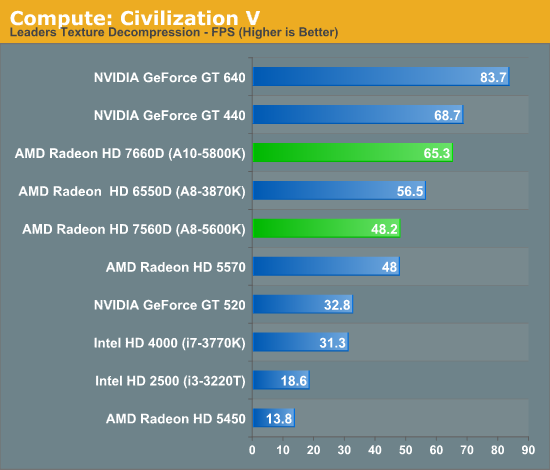
Similar to what we've already seen, Trinity offers a 15% increase in performance here compared to Llano. The compute advantage here over Intel's HD 4000 is solid as well.
Our next benchmark is SmallLuxGPU, the GPU ray tracing branch of the open source LuxRender renderer. We're now using a development build from the version 2.0 branch, and we've moved on to a more complex scene that hopefully will provide a greater challenge to our GPUs.
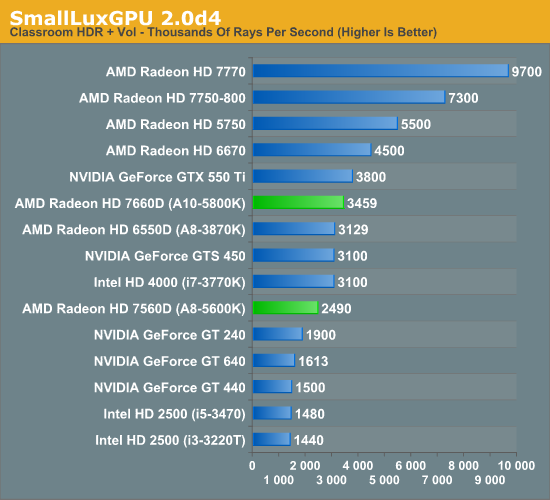
Intel significantly shrinks the gap between itself and Trinity in this test, and AMD doesn't really move performance forward that much compared to Llano either.
For our next benchmark we're looking at AESEncryptDecrypt, an OpenCL AES encryption routine that AES encrypts/decrypts an 8K x 8K pixel square image file. The results of this benchmark are the average time to encrypt the image over a number of iterations of the AES cypher. Note that this test fails on all Intel processor graphics, so the results below only include AMD APUs and discrete GPUs.
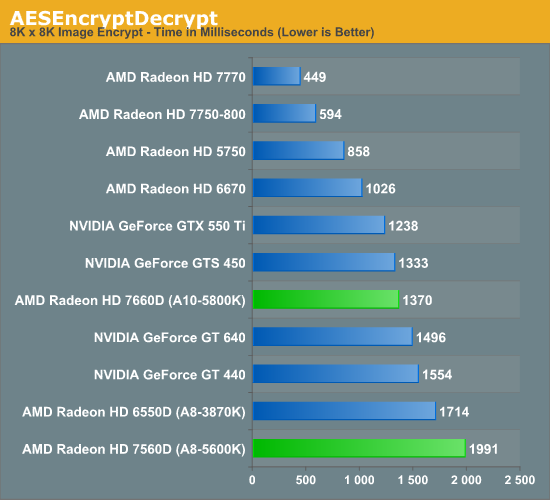
We see a pretty hefty increase in performance over Llano in our AES benchmark. The on-die Radeon HD 7660D even manages to outperform NVIDIA's GeForce GT 640, a $100+ discrete GPU.
Our fourth benchmark is once again looking at compute shader performance, this time through the Fluid simulation sample in the DirectX SDK. This program simulates the motion and interactions of a 16k particle fluid using a compute shader, with a choice of several different algorithms. In this case we're using an (O)n^2 nearest neighbor method that is optimized by using shared memory to cache data.
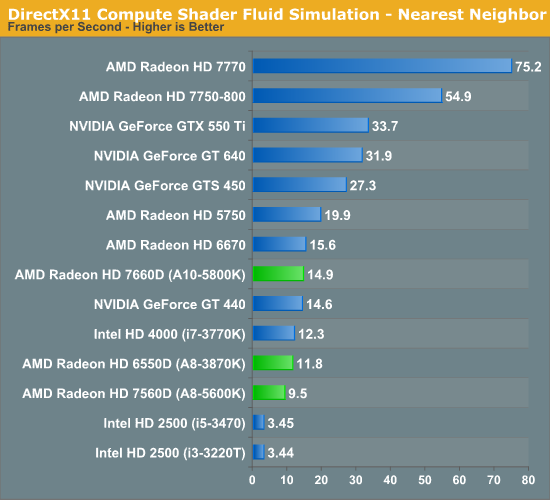
For our last compute test, Trinity does a reasonable job improving performance over Llano. If you're in need of a lot of GPU computing horsepower you're going to be best served by a discrete GPU, but it's good to see the processor based GPUs inch their way up the charts.
Synthetic Performance
Moving on, we'll take a few moments to look at synthetic performance. Synthetic performance is a poor tool to rank GPUs—what really matters is the games—but by breaking down workloads into discrete tasks it can sometimes tell us things that we don't see in games.
Our first synthetic test is 3DMark Vantage's pixel fill test. Typically this test is memory bandwidth bound as the nature of the test has the ROPs pushing as many pixels as possible with as little overhead as possible, which in turn shifts the bottleneck to memory bandwidth so long as there's enough ROP throughput in the first place.
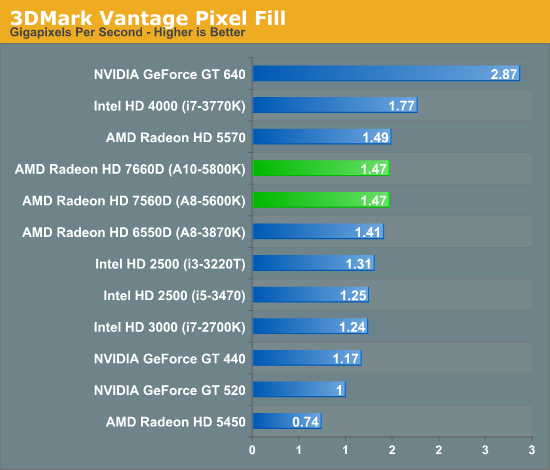
Since our Llano and Trinity numbers were both run at DDR3-1866, there's no real performance improvement here. Ivy Bridge actually does quite well in this test, at least the HD 4000.
Moving on, our second synthetic test is 3DMark Vantage's texture fill test, which provides a simple FP16 texture throughput test. FP16 textures are still fairly rare, but it's a good look at worst case scenario texturing performance.

Trinity is able to outperform Llano here by over 30%, although NVIDIA's GeForce GT 640 shows you what a $100+ discrete GPU can offer beyond processor graphics.
Our final synthetic test is the set of settings we use with Microsoft's Detail Tessellation sample program out of the DX11 SDK. Since IVB is the first Intel iGPU with tessellation capabilities, it will be interesting to see how well IVB does here, as IVB is going to be the de facto baseline for DX11+ games in the future. Ideally we want to have enough tessellation performance here so that tessellation can be used on a global level, allowing developers to efficiently simulate their worlds with fewer polygons while still using many polygons on the final render.
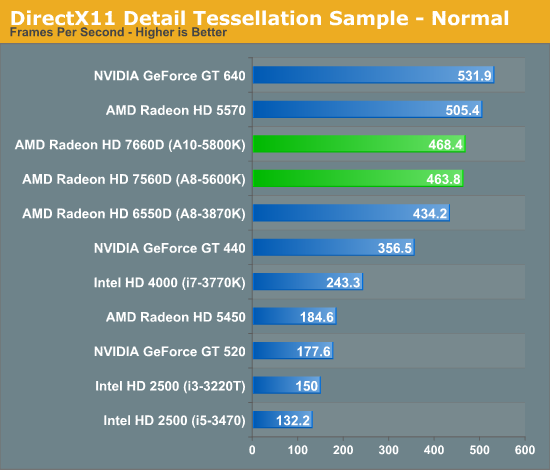
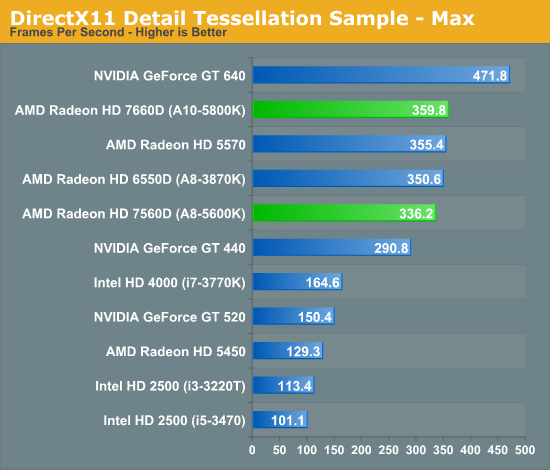
The tessellation results here were a bit surprising given the 8th gen tessellator in Trinity's GPU. AMD tells us it sees much larger gains internally (up to 2x), but using different test parameters. Trinity should be significantly faster than Llano when it comes to tessellation performance, depending on the workload that is.










139 Comments
View All Comments
OCedHrt - Thursday, September 27, 2012 - link
The Adobe suite is quite well GPU accelerated now. I'll admit Intel still wins on video encoding by far though. And we just saw how Trinity won at gaming, what are you saying?StevoLincolnite - Thursday, September 27, 2012 - link
Actually... The higher the resolution the smaller the increase in performance a processor provides as you quickly become GPU limited.I game at 5760x1080 and I noticed zero, I mean zero difference in games between a Phenom 2 x6 1090T and my current Core i7 3930K.
Granted I use that CPU grunt for other things, but in gaming and at super high resolutions, the difference is absolutely negligible.
I would have been better off using the $800 that I spent upgrading for another 2 graphics cards for Quad-Crossfire if the sole purpose was gaming.
CeriseCogburn - Thursday, October 11, 2012 - link
Don't you love it how with the amd HD7970 etc all their videocards, all we heard about was future proofing and having 2G+ 3G+ ram on board so that WHEN the time came and games were released the dear fanboy amd card could finally show it's unlocjked potential and futureproofiness !LMAO - now a crap trinity slug is all anyone will ever need.
It's amazing what size brain farts the amd fanboy mind can flatulate.
daos - Thursday, September 27, 2012 - link
Not trying to knock AMD at all here either. I want to make that clear. I am simply saying that Intel is the performance king. Once can argue that power consumption is not a concern but performance is.tecknurd - Thursday, September 27, 2012 - link
What blackmagnum means is back in the old days AMD suit the best price vs performance ratio.. These days AMD is not doing this. It nice to get a processor that is as powerful or fast as Intel high-end processor which is i7 for the price of an i5 or even an i3. This provides a good selling point. If user went with a lower end AMD processor, people will be paying less than a Pentium, but get the same performance as an i5 or an i3. It was like this in the past, but again it is not now. AMD's processors have a poor price to performance ratio that is making them more expensive than Intel's processors. Intel has the best price to performance ratio.If you do not believe me, an AMD K7 processor compared well against Intel Xeon processor. Also an AMD K8 processor compared well against Intel Xeon processor. The AMD K10 processor and now compared well against Intel low-end processors like the Pentium, but at a rip off price that is a few times more.
It is already given that an SSD increases performance of a computer because the latency is less than a millisecond and throughput is more than 100 megabytes per second. A HDD latency is about 10 millisecond and throughput is average around 40 to 60 megabytes per second.
vgray35@hotmail.com - Thursday, September 27, 2012 - link
The bottom line here is graphics fusion onto the CPU chip is moving extremely slowly. AMD is now as slow or slower than Intel in moving the technology forward. The incremental improvements from one generation to the next are certainly not spectacular. Intel is slow as they traditionally are too conservative and GPU design has never been their forte. Now AMD is slow as big improvements will eat into their graphics cards business.AMD is backing itself into a corner that it may not ever recover from if it does not make big moves soon. My advise - skip 22nm lithography and go straight to 14nm to 18nm with 5 billion transistors, and increase graphics performance by at least 150% to 200%. Bite the bullet and move low to medium end discrete graphics onto the APU as originally promised. Intel will not be able to match this for at least 2 to 3 years (unless they buy NVidia). Forget power consumption beyond 65W.
They do not need to beat Intel in CPU performance, but it is ridiculous to produce a chip with only 1.1 billion transistors that offers both CPU and GPU cores at this late stage of the game. When Intel moves to 14nm the state of AMD's development at that time will determine AMD's fate once and for all. They had better get a clue and skip one lithographic generation.
I have always favored AMD for its agility in the past, but for years I have been sadly watching the death of this company. It's not too late, but 2 years is all they have left to provide a large incremental jump. It's now or never. The next generation on the new FM2 socket is just not going to cut it either, as the next chip should integrate the south bridge, as well as audio to create a true SoC offering.
Can you believe a new platform that does not even offer PCI Express 3.0? Ridiculous really. Forget 3Gbps SATA. Forget USB 2.0 ports. Produce what we have all been waiting for - a SoC for the desktop, which is what fusion was all about in the first place. If it needs a new APU socket then just bite the bullet and introduce another one, and give it some spare pins for future growth.
Time to get serious. before the money runs out.
mikato - Monday, October 1, 2012 - link
Well just wait until some of the bigger name applications out there start using the GPU a bit. Could be interesting. Hopefully it's sooner rather than later. They do have a way to go with sorting out the best ways to do this.jjj - Thursday, September 27, 2012 - link
I had one question about desktop Trininty: how does it do at 1080p? and i guess i'll have to look for an answer elsewhre.It's a desktop part,you just can't not even try testing at 1080p.
Bah!
Mathieu Bourgie - Thursday, September 27, 2012 - link
I'm also disappointing in the lack of testing at 1080p. Many folks, myself included, are considering Trinity for a HTPC solution and needless to say, the vast majority of hooked to HDTVs, most of them being 1080p. Not to mention that 1080p screens for desktop PCs are quite inexpensive and pretty common nowadays.Also, shame on AMD for those shady marketing tactics. To me, it sounds like CPU performance and overclocking are poor and pricing will most likely depend on reaction to
Mathieu Bourgie - Thursday, September 27, 2012 - link
Sorry about that, I meant to say in my last sentence:"To me, this marketing strategy from AMD is telling me that CPU performance and overclocking potential are most likely poor and that pricing will most likely depend on the reaction of the public and the PC industry after reading these so called "reviews"."